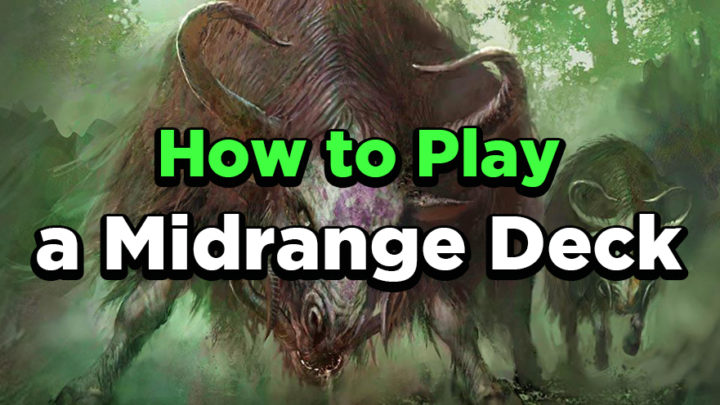Welcome back to Card Kingdom for another “How to Play” archetype breakdown. Today, we’ll be focusing on the most popular macro-archetype in current Standard: Midrange. Be sure to check out Tom Anderson’s guide on aggro decks, and be on the lookout for control and combo primers in the future.
What is Midrange?
Magic decks exist on a spectrum, with fast, aggressive decks on one end and slower, more controlling decks at the other. You could also define this spectrum based on how much each deck wants to interact with an opponent. Simply put, midrange decks fall into the middle of that spectrum. Aggro decks usually include minimal interaction to focus directly on dealing damage to the opponent, whereas control decks interact heavily. A midrange deck has properties of aggro and control, capable of playing the role of the aggressor or the control depending on the situation.
Here’s an example:
Lurrus Jund by Reid Duke

4 Blackcleave Cliffs
1 Blood Crypt
3 Bloodstained Mire
1 Forest
1 Mountain
1 Nurturing Peatland
2 Overgrown Tomb
2 Raging Ravine
1 Stomping Ground
2 Swamp
4 Verdant Catacombs
1 Wooded Foothills
4 Mishra’s Bauble
1 Fatal Push
4 Inquisition of Kozilek
2 Thoughtseize
3 Lightning Bolt
2 Seal of Fire
2 Nihil Spellbomb
2 Dark Confidant
2 Scavenging Ooze
4 Tarmogoyf
2 Kroxa, Titan of Death’s Hunger
1 Abrupt Decay
1 Assassin’s Trophy
3 Wrenn and Six
3 Kolaghan’s Command
1 Maelstrom Pulse
SIDEBOARD
3 Pillage
2 Boil
3 Collective Brutality
1 Veil of Summer
2 Engineered Explosives
2 Nihil Spellbomb
1 Weather the Storm
1 Lurrus of the Dream-Den
Modern Jund is a classic midrange deck. Tarmogoyf, Scavenging Ooze, and Dark Confidant can pressure interactive decks early, or hold the ground against a more aggressive opponent. Kroxa can strain resources in just about any match-up while being a nightmare for control players later in the game. The rest of Jund’s main deck is devoted to being as interactive as possible to back up these cheap creatures.
Deck-Building and Tuning
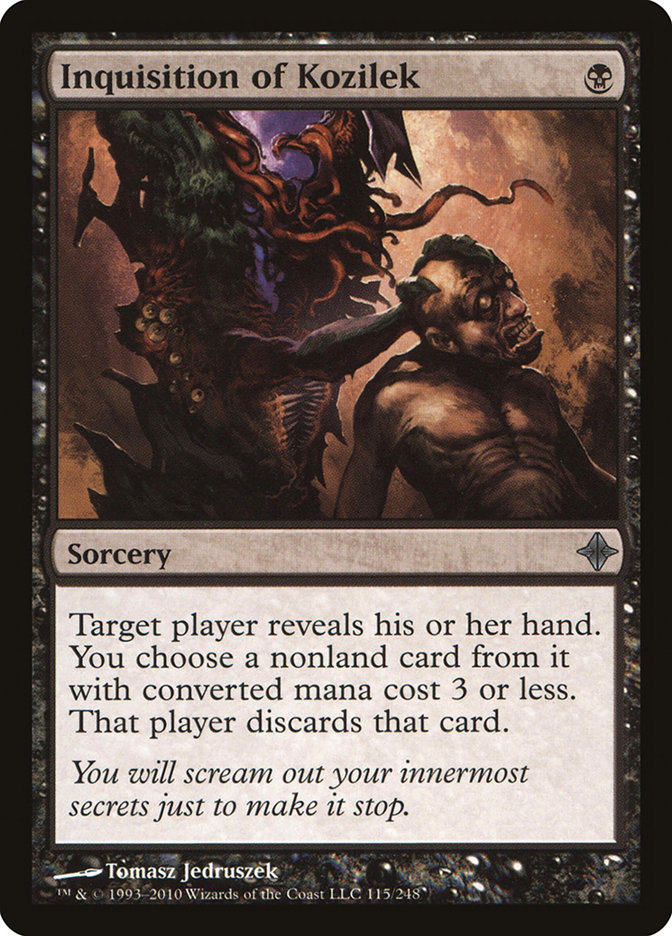
Midrange decks typically have powerful but narrow answers that need to be examined on a tournament-by-tournament basis. As the decks in a format change, your plan to attack them will need to change, too.
Reid Duke is known for playing Jund, and his choices in building the list above belie his knowledge of the current Modern metagame. Fatal Push used to be the go-to removal spell for Jund, but now that Lurrus is running around in Modern, Lightning Bolt’s stock rises, and suddenly even Seal of Fire is showing up. Four Inquisition of Kozilek and two Thoughtseize is a relatively classic split for Jund, and is even more correct now that decks are playing even more one- and two-mana spells than they would otherwise. You’ll also need to adjust your sideboard constantly to account for the metagame; Reid’s list includes two copies of Boil as a hedge against both the blue Scapeshift decks and the Yorion decks that can be tough match-ups for Jund.
Threat Assessment
Threat assessment is an important concept to understand if you’re going to get the most value out of your cards. When you’re playing a midrange deck, you’ll have limited threats and limited answers compared to your aggro and control counterparts, so you’ll need to use them wisely.
Example #1: Aggro
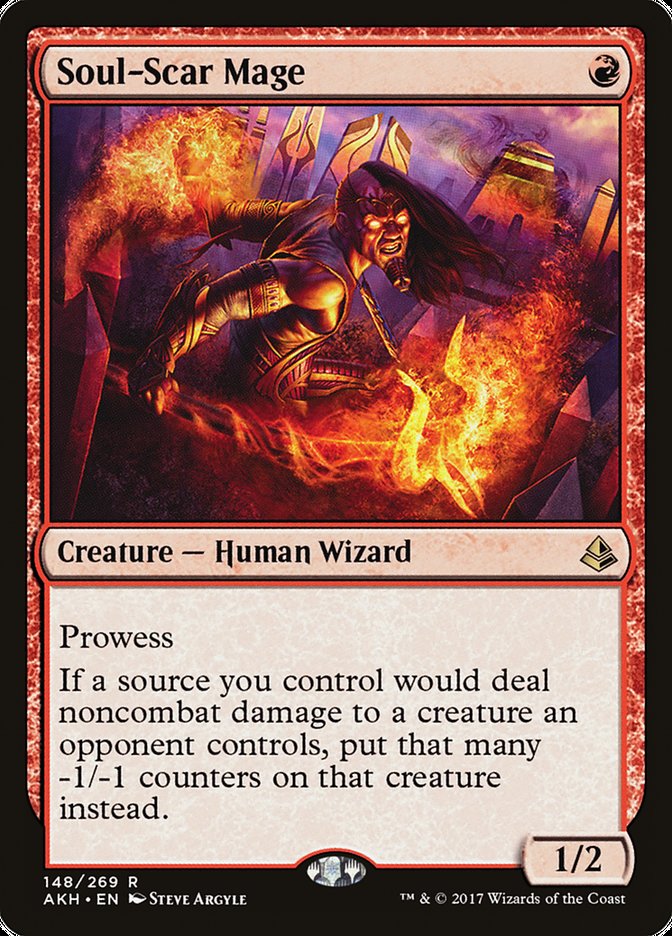
Let’s say you’re playing against Rakdos Prowess and your opponent has had a good start. They play a Soul-Scar Mage on turn one; then, on turn two, they play a Mishra’s Bauble, a Manamorphose, a second Manamorphose, and a Lava Spike. Suddenly, you’re down three life points and staring down five more points of damage!
Can you afford to use your only removal spell on this Soul-Scar Mage? It looks awfully attractive to avoid taking five damage, but you have to think about whether you can beat the Lurrus that is likely coming down the following turn. If you choose to kill the Soul-Scar Mage, you MUST draw another removal spell for the Lurrus; if you don’t, you risk getting hit by the Soul-Scar Mage again or buried in card advantage when your opponent casts Mishra’s Bauble again and again.
Example #2: Control
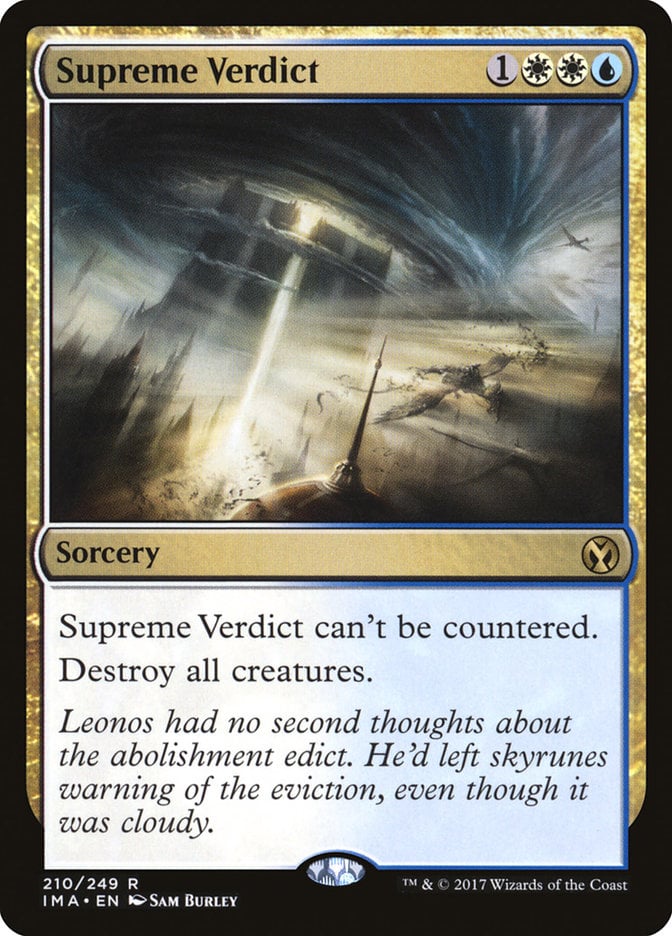
Threat assessment is important in control match-ups, too. Any tool a control player can use to stymie your game plan is a threat that you’ll need to evaluate and consider answering.
Let’s say you cast Thoughtseize on turn three targeting your Azorius Control opponent, revealing Supreme Verdict, Flooded Strand, and Jace, the Mind Sculptor. Which card you take depends on what you have in play. If you have a Tarmogoyf and a Dark Confidant in play and you take the Jace, your opponent is likely to cast Supreme Verdict, which opens up a lot of lines of play for them the following turn. In this scenario, Jace is less of a threat than Supreme Verdict.
If your opponent casts Jace, they have three options:
- +2, then Jace dies in combat to both creatures.
- 0, then Jace dies to Tarmogoyf while you attack your opponent with Dark Confidant.
- -1 to bounce one of your creatures, then Jace dies to the other one.
On the surface, Jace may look like the most threatening card in your opponent’s hand. But, when you have two creatures in play, he doesn’t have quite the same impact. If your opponent gets to cast Supreme Verdict, they have a much easier time clawing back into the game.
Pacing the Game

Pacing the game is a nearly universal skill, but midrange decks give you the option of adjusting. Aggro decks really only function in one way: being the aggressor and forcing the opponent to react. Control decks lose if they can’t play at their own pace. The beauty of midrange decks is that they have the fluidity and tools to both set the pace of the game and respond to an opponent that is in control of the pace.
When you are able to dictate the pace of play, it can limit the number of available plays from your opponent. Let’s go back to our example about Supreme Verdict and Jace. Taking the Supreme Verdict allows us to not only keep the initiative, but makes it difficult for the opponent to get back to a comfortable pace.
Midrange decks can also dictate the pace of a game by using versatile creatures, like Tarmogoyf. Tarmogoyf often comes into play as a 3/4 or a 4/5, which effectively walls off opposing aggression or allows you to pressure a more reactive opponent. It doesn’t look like much, but Tarmgoyf does honest work.
Turning the Corner
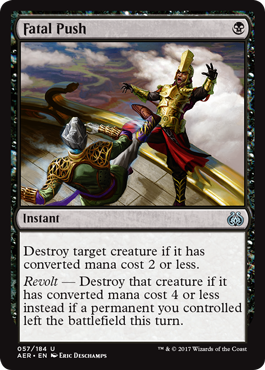
“Turning the corner” is a phrase you’ll often hear in discussions about midrange decks. It refers to the point in the game where you move from a reactive stance to a proactive one. It’s hard to know when you should turn the corner in a game, as it often depends on context. However, there are some guidelines you can use:
- Once you feel that you have an advantage in the game, you can press that advantage to close the game before your opponent can recover
- If you’re ahead on board and have a removal spell in hand, chances are that you’ll be able to win a race
Sometimes the opportunity to turn the corner comes later in the game, once you’ve run your opponent out of resources. You should always be on the lookout for your chance to turn the corner and become the aggressor, as it’ll convert into quite a lot of wins.
Conclusion
Hopefully I’ve provided you with a deeper understanding of how to play my favorite strategy in Magic. Naturally, there’s always more to learn, but these tips should give you a solid foundation. If you’re looking for tips on how to play a specific midrange deck in Modern, be sure to check out our deck guides for Grixis Death’s Shadow, Jund, and more!

Michael Rapp is a Modern specialist who favors Thoughtseize decks. Magic sates his desire for competition and constant improvement.

